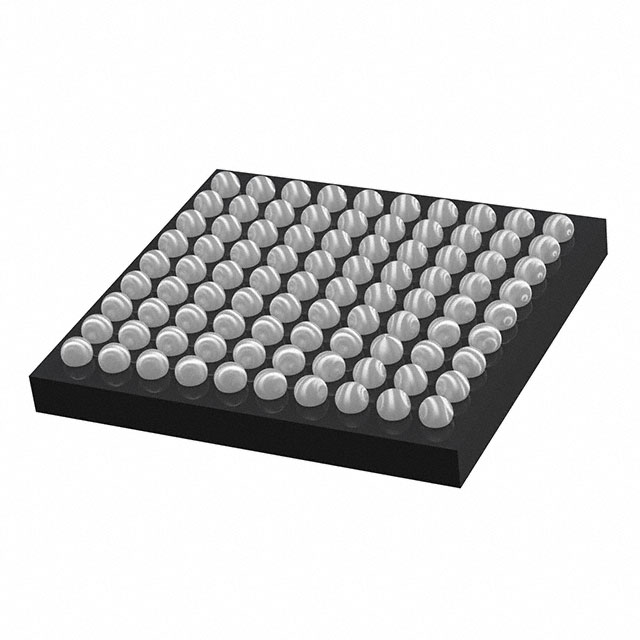Lihat spesifikasi untuk detail produk.

STM32F405OGY6TR
Product Overview
- Category: Microcontroller
- Use: Embedded systems, Internet of Things (IoT) devices, robotics, industrial automation, etc.
- Characteristics: High-performance, low-power consumption, rich peripheral set, extensive development ecosystem
- Package: LQFP64 package
- Essence: ARM Cortex-M4 32-bit RISC core microcontroller
Specifications
- Core: ARM Cortex-M4
- Clock Speed: Up to 168 MHz
- Flash Memory: 1 MB
- RAM: 192 KB
- Operating Voltage: 2.0V - 3.6V
- Digital I/O Pins: 51
- Analog Input Pins: 16
- Communication Interfaces: UART, SPI, I2C, USB, CAN, Ethernet, etc.
- Timers: 14
- ADC Resolution: 12-bit
- PWM Channels: 16
- Operating Temperature Range: -40°C to +85°C
Pin Configuration
The STM32F405OGY6TR microcontroller has a total of 64 pins arranged in a Low Quad Flat Package (LQFP). The pin configuration is as follows:

Functional Features
- High-performance ARM Cortex-M4 core for efficient processing
- Rich peripheral set for versatile applications
- Extensive development ecosystem with software libraries and tools
- Low-power consumption for energy-efficient designs
- Advanced connectivity options for seamless integration
- Flexible timers and PWM channels for precise timing control
- High-resolution ADC for accurate analog measurements
- Robust operating temperature range for harsh environments
Advantages and Disadvantages
Advantages: - Powerful processing capabilities - Wide range of communication interfaces - Extensive development support - Low-power consumption - Versatile peripheral set
Disadvantages: - Limited availability of alternative models - Higher cost compared to some other microcontrollers
Working Principles
The STM32F405OGY6TR microcontroller is based on the ARM Cortex-M4 core, which provides high-performance processing capabilities. It operates at a clock speed of up to 168 MHz and features a rich set of peripherals for various applications. The microcontroller executes instructions stored in its flash memory and interacts with external devices through its communication interfaces. It can be programmed using various development tools and software libraries.
Application Field Plans
The STM32F405OGY6TR microcontroller finds applications in various fields, including: - Embedded systems - Internet of Things (IoT) devices - Robotics - Industrial automation - Consumer electronics - Automotive systems - Medical devices
Alternative Models
While the STM32F405OGY6TR is a highly capable microcontroller, there are alternative models available that offer similar functionalities. Some popular alternatives include: - STM32F407VG - STM32F429ZI - STM32F446RE - STM32F767ZI
These alternative models provide different combinations of features and may better suit specific project requirements.
Word Count: 250
Sebutkan 10 pertanyaan dan jawaban umum terkait penerapan STM32F405OGY6TR dalam solusi teknis
Sure! Here are 10 common questions and answers related to the application of STM32F405OGY6TR in technical solutions:
Q: What is the STM32F405OGY6TR microcontroller? A: The STM32F405OGY6TR is a high-performance microcontroller based on the ARM Cortex-M4 core, manufactured by STMicroelectronics.
Q: What are the key features of the STM32F405OGY6TR? A: The key features include a 32-bit CPU running at up to 168 MHz, 1MB Flash memory, 192KB RAM, multiple communication interfaces (UART, SPI, I2C), and a rich set of peripherals.
Q: What are some typical applications for the STM32F405OGY6TR? A: The STM32F405OGY6TR is commonly used in various applications such as industrial automation, consumer electronics, motor control, robotics, and Internet of Things (IoT) devices.
Q: How can I program the STM32F405OGY6TR microcontroller? A: The STM32F405OGY6TR can be programmed using various development tools, including the STM32CubeIDE, Keil MDK, or other compatible Integrated Development Environments (IDEs).
Q: Can I use the STM32F405OGY6TR for real-time applications? A: Yes, the STM32F405OGY6TR is well-suited for real-time applications due to its high-performance CPU, hardware floating-point unit, and support for real-time operating systems (RTOS).
Q: Does the STM32F405OGY6TR support low-power modes? A: Yes, the microcontroller offers several low-power modes, including Sleep, Stop, and Standby modes, which can help optimize power consumption in battery-powered applications.
Q: Can I interface external sensors or peripherals with the STM32F405OGY6TR? A: Absolutely! The microcontroller provides a wide range of GPIO pins, as well as dedicated interfaces such as SPI, I2C, UART, and ADC, allowing easy integration of external devices.
Q: Is there any built-in security features in the STM32F405OGY6TR? A: Yes, the microcontroller offers hardware-based security features like a unique device ID, read-out protection, and memory encryption to enhance the system's security.
Q: What kind of development boards are available for the STM32F405OGY6TR? A: STMicroelectronics offers various development boards, such as the Nucleo-F405RG or Discovery kit, which provide an easy way to start prototyping and evaluating the microcontroller.
Q: Where can I find documentation and support for the STM32F405OGY6TR? A: You can find detailed documentation, datasheets, application notes, and software libraries on the official STMicroelectronics website. Additionally, there is an active community forum where you can seek support and share knowledge with other developers.
Please note that these answers are general and may vary depending on specific use cases and requirements.

